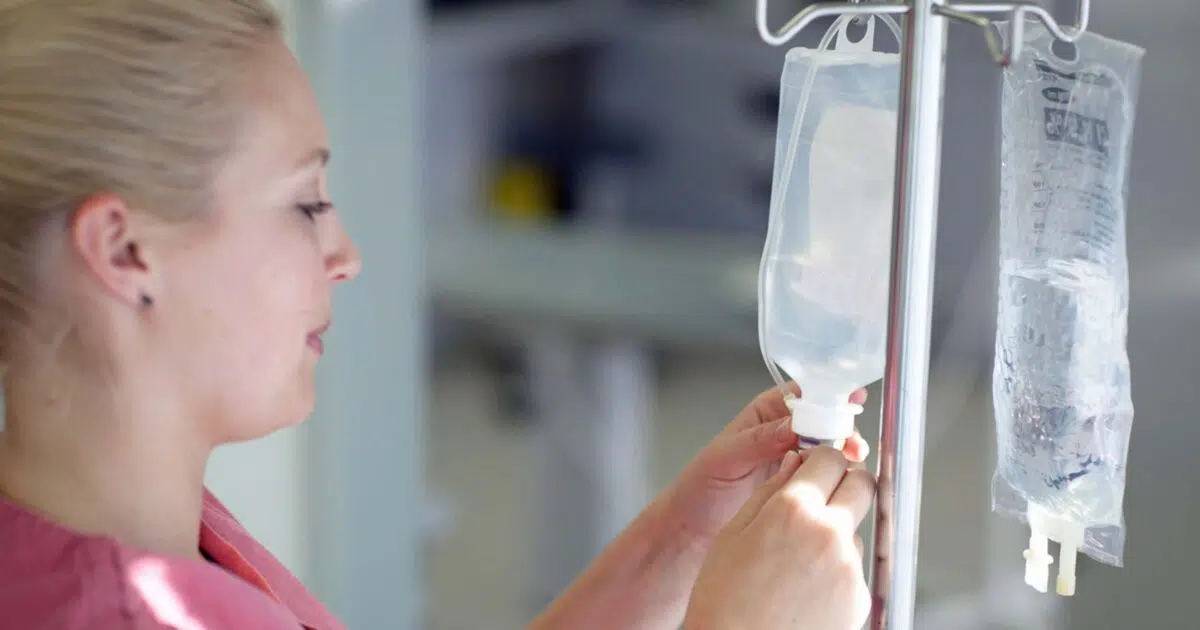Nurses are the primary care providers within an acute care setting and frequently give medications to patients. When delivering prescribed drugs to patients, nurses are the gatekeepers to patient safety and preventing errors. It’s their responsibility to understand and implement the expanded 10 rights of medication administration so they know how and why these rights are used.
Medication Administration and Medication Errors
According to a study posted on the National Library of Medicine site, medication errors are the most common and preventable cause of patient injury and death. Reported medication errors happen in acute care settings at a rate of 6.5% and contribute to 44,000 to 98,000 hospital deaths annually.
It’s important to understand that this number is likely not an accurate representation of actual medication errors, just the reported numbers. For a medication error to be reported and included in these numbers, a nurse must first recognize the mistake and then lean on nursing ethics associated with acknowledging and reporting it.
Contributing Factors to Medication Errors
Patient load and acuity may make a nurse less diligent when administering medications, leading to mistakes that cause anxiety. If you’re a new nurse struggling with this task, ask for help from senior staff or seek a nurse mentor for tips on managing your time. Medication administration is never a task to rush.
Utilizing the 10 rights of medication administration throughout the medication process helps you stay focused on the task and reduce errors. Over time, medication rights may become a subconscious act for many nurses, but these rights must always remain a top priority to decrease medication errors and increase patient safety.
The 10 Rights of Medication Administration
The original five rights of medication administration are:
1. Right Patient
2. Right Drug
3. Right Dose
4. Right Time
5. Right Route
Additional medication rights were later introduced to enhance medication safety even further. These include:
6. Right Documentation
7. Right Reason
8. Right Response
9. Right Education
10. Right to Refuse
1. Right Patient
When administering medication, the nurse must ensure it’s for the right patient. To complete patient verification, confirm two separate verifiers on the medication administration record (MAR). Typically, the nurse verifies the patient’s identity by asking for their full name and birthdate and checking their wristband. The hospital wristband has a medical record (MR) number the nurse must match with the MR number on the chart. For accuracy, the nurse compares these identifiers to the name and birthdate on the MAR.
To decrease medication errors, the best practice is to bring the MAR to the bedside to verify a patient’s identity. All patients in acute care settings must have their identity verified and wear a wristband on admission. In some cases, like psychiatric settings, patients may not wear wristbands or be able to tell you their identity. In these cases, the nurse administering medicines must ensure the right patient by confirming the patient’s identity through a nurse who’s familiar with them. Also, a picture of the patient will usually be attached to the MAR to ensure accuracy with administration.
2. Right Drug
When administering medication, you must confirm that the prescribed drug is correct for the patient. Some medicines have very similar spelling, or doctors will use trade names, while hospitals provide medications by their generic names. Take your time and read the whole medication name, and ensure accuracy in knowing your generic and trade names. When in doubt, look up the medication using a reliable source like Davis’s Drug Guide for Nurses.
Some facilities have paper charts that require physicians to write orders on paper, which a nurse or unit clerk then transcribes onto the MAR. Policies are in place to safeguard this process and ensure proper transcription. For example, when one nurse writes a medication on the MAR, another nurse must double-check it for accuracy.
More often than not, a physician’s writing is challenging to decipher. Sometimes, it can take a team approach to decode the medication and dosage a physician prescribed. Many medications have a specific dosage, and working with familiar doctors makes it easier to understand what they’ve written. To be honest, I find this one of the trickiest parts of travel nursing—learning the doctor’s script and deciphering new handwriting.
If you’re ever unsure what an order says, ask the unit’s senior nurses for help reading orders. When in doubt, call the doctor. It’s also their responsibility to help decrease medication errors, and that process starts with prescribing and transcribing with accuracy.
3. Right Dose
As a nurse, knowing and understanding standard dosing for medication is essential. Sometimes, a dose must be calculated based on a patient’s weight, especially for children. A nurse must obtain an independent double-check with calculated medication doses when working in pediatrics. An independent double-check involves another nurse independently performing the calculations without seeing your results and comparing the answers for accuracy. High-alert medications, such as insulin and low molecular weight heparins, also warrant an independent double-chek.
If you notice an incorrect dose for your patient or have concerns about a high or low dose, take your time and question it. If something seems off, clarify with the physician or pharmacist to avoid mistakes.
The pharmacy is a massive asset for drug and dosage knowledge and is crucial in reducing medication errors. Pharmacists are experts in dosing and drug interactions, as they must thoroughly examine all electronic or paper orders for accuracy.
4. Right Time
Nurses should administer medications prescribed by the physician as directed, spacing dosages appropriately to achieve and sustain therapeutic effects. Timely administration is crucial for regularly scheduled medications, preoperative drugs and for pain relief to ensure patient comfort.
Nurses should stay within a half-hour window from the prescribed time to ensure medication accuracy and maintain therapeutic levels of the drug. For example, it’s crucial to administer insulin before meals but wait until the meal arrives to avoid hypoglycemia. Other medications, like pantoprazole, should be taken one hour before a meal for optimal effectiveness.
5. Right Route
Nurses administer medication to patients through various routes, each of which can significantly impact absorption time and the overall effectiveness of the treatment. Some common routes of administration, with their abbreviations, include:
- Intravenous (IV)
- Oral (PO)
- Rectal (PR)
- Nasogastric (NG)
- Subcutaneous (SC)
- Sublingual (SL)
- Intramuscular (IM)
- Topical (TOP)
Properly selecting the administration route ensures the patient receives the optimal therapeutic benefit while minimizing potential side effects.
Typically, the doctor specifies the route to deliver a specific drug, but there are instances when a patient’s order may give options, and the nurse needs to decide the best route.
Here’s a potential Dimenhydrinate order a doctor may prescribe to a patient for nausea:
Dimenhydrinate 25 to 50 mg IV/IM/PO/NG Q4H PRN
To choose the best route, the nurse must assess the severity of the nausea. If the patient is experiencing severe nausea and vomiting, IV administration would be the most effective. For mild cases of nausea, PO medication would work. However, if the patient can’t take anything by mouth (NPO) and has an NG tube placed, then NG administration may be the best option.

6. Right Documentation
Documenting medication delivery ensures the nurse and team know they administered the prescribed medicine correctly. Usually, the MAR will specify the date, time, dose, route and medication, and the nurse then signs off after they give it. However, if the medication is on an as-needed basis (PRN), it’s usually documented in a separate area, and the nurse must ensure they document the proper dosage and time. Again, this helps to eliminate medication errors.
For example, if your patient was exhibiting 7/10 pain, and you gave them 2 mg of IV hydromorphone before your break and didn’t document it, another nurse may check on your patient, assess their pain and see the need for pain medication. The nurse covering your break may give another dose if there’s no documented record of the medication you gave. This medication error is particularly concerning for a narcotic due to the heightened risk of delirium in older patients, as well as the potential for overdose resulting in respiratory depression.
When you give PRN medication, it’s also important to document why you gave it to the patient, the non-pharmacological interventions you tried before or alongside it and the medication’s effect.
7. Right Reason
As the administering nurse, you must understand the purpose behind each medication prescribed to your patient. Administering medication for its intended purpose is essential for patient safety and effective treatment.
Understanding drug interactions and contraindications is equally important. Knowing how the prescribed medication interacts with other drugs that your patient is taking can prevent adverse reactions. Being aware of contraindications helps you avoid administering a medication that could potentially harm the patient due to their specific medical conditions or other factors. This comprehensive understanding ensures the highest level of care and promotes better patient outcomes.
8. Right Response
Patients receive medication to help with specific symptoms. Different medications work differently for everyone, making it essential to assess whether a patient is responding appropriately to a prescribed drug. This response is particularly critical when caring for elderly patients.
For example, many physicians prescribe antipsychotics like haloperidol for elderly patients to manage delirium symptoms and ensure patient safety when these symptoms become unmanageable. Unfortunately, in many cases, haloperidol can have the opposite effect on seniors, leading to increased anxiety and agitation instead of the intended drowsiness and sedation. In such instances, it’s essential to document the patient’s response and report it to the doctor and other nursing staff. This communication helps ensure the reassessment of the medication and exploration of alternative treatments.
9. Right Education
Nurses play a vital role in educating patients about their diagnoses and the medications they’re receiving. Clear and understandable communication is crucial to ensure patients fully grasp their treatment plan. Here are key points to include in patient education:
- Reason for Prescription
- Desired Effects
- Dosage and Frequency
- Route of Administration
- Possible Side Effects
10. Right to Refuse
Patients have the right to refuse all or some of their prescribed care. For example, a patient may refuse a bath, a procedure, physical therapy or medication. As nurses, it’s our responsibility to question this refusal and provide adequate education so the patient can make an informed decision.
Patients may refuse medication for many reasons, such as religious beliefs, lack of knowledge or fear of the drug. If they refuse, you should educate the patient and possibly their caregiver about the possible consequences of not taking the prescribed medicine and notify the physician. As the nurse, you must enter detailed documentation regarding a patient’s refusal on the chart.
Results of Using the 10 Rights of Medication Administration
As a frontline nurse, ensuring patient safety is a top priority. By adhering to the expanded 10 rights of medication administration, you do your due diligence to decrease medication errors and hold patient safety to the highest standard. We became nurses to help people and provide them with the best care possible, so let’s keep doing just that.
Create your Vivian Health profile to receive customized job opportunities tailored to your credentials and career goals, delivered straight to your phone via text messages.
Disclosure: We may receive compensation if you click on the included links.











Right reason
Hello Keyna and thanks for reaching out! Right reason is included in #7.
Very informative